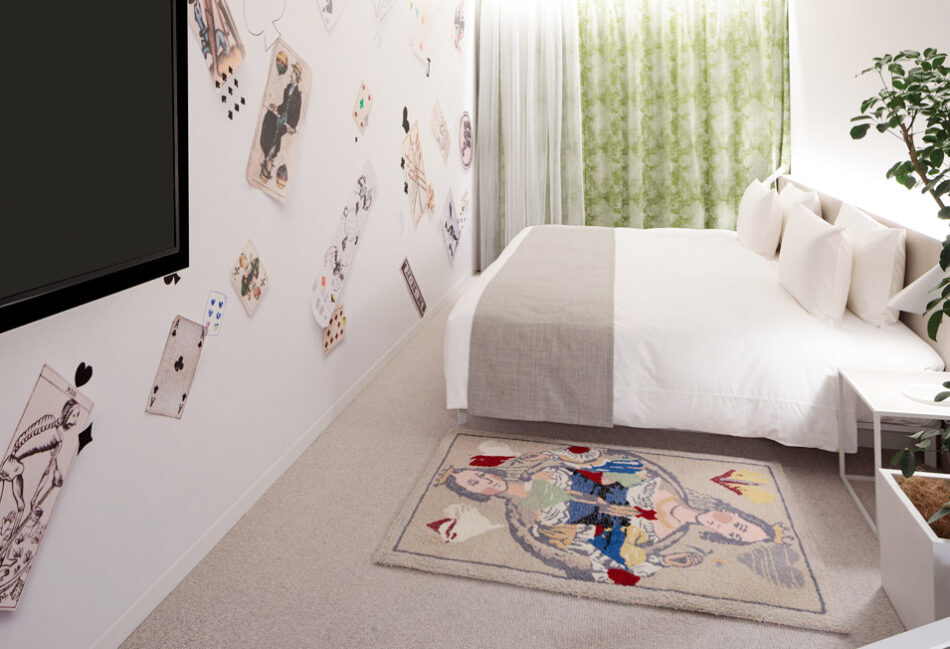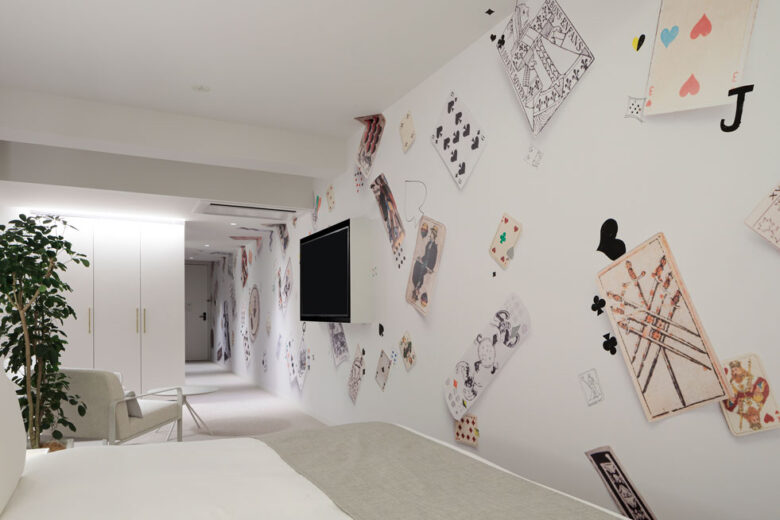ROOM 18 竹村 京 / KEI TAKEMURA


Playing Cards on the Wall of S.Hotel

Spade 5 on Heart King

部屋に入って最初に目に入るのが、壁一面のトランプの壁紙だろう。よく見ると、壁紙の上にはペンで直接描き込まれている箇所もある。写真やドローイングと刺繍を組み合わせた作品などで知られる、竹村京のアートワークである。
竹村は、1975年東京都に生まれ、1998年東京藝術大学美術学部絵画科油画専攻を卒業。2002年に同大学美術研究科修士課程絵画専攻(油画)を修了し、2004年にはベルリン芸術大学を卒業、同年から2007年文化庁芸術家在外研修員としてベルリンに滞在した。現在は、帰国し、群馬県を拠点に活動する。近年は、蛍光シルクを使用し、重なり合う過去と現在の記憶や、時間を可視化する作品を制作する。主な展覧会に、第15回シドニー・ビエンナーレ(2006年)、「どの瞬間が一番ワクワクする?」(ポーラ美術館アトリウムギャラリー、2018年)、「まえといま」(群馬県立近代美術館、2019年)、ヨコハマトリエンナーレ2020(横浜美術館、2020年)などがある。
大学卒業後、15年間ドイツで作家活動を続けた竹村にとって、トランプは重要なコミュニケーション・ツールであり、主要なモティーフである。これまでに竹村は、さまざまな国のさまざまな時代のトランプに、そのカードとは別の国、別の時代にデザインされたカードのイメージを刺繍で重ねることによって、異なる文化と時代をつなぐ試みを続けてきた。ここでは刺繍の代わりに、壁紙の上にドローイングを重ねている。トランプは国によって枚数やデザインに違いがあるものの世界中で製造され、使用されており、言葉や文化、世代の違いを超えて人と人をつなぐことができる。この部屋は、さまざまな国から訪れた滞在者を温かく迎える準備ができている。
When you enter this room, the first thing you will notice is the playing cards covering the wall. Look closely, and you will see that the artist has added some drawings in pen on the wallpaper. This artwork was created by Kei Takemura, who is known for combining paintings, drawings, and embroidery in her work.
Takemura was born in Tokyo in 1975. She graduated from the Oil Painting Course, Department of Painting, Faculty of Fine Arts at Tokyo University of the Arts in 1998, and completed her master’s degree in oil painting in 2002.She then graduated from Berlin University of the Arts in 2004 before spending three years in the same city as a trainee with the Japanese government’s Agency for Cultural Affairs. She has since returned to Japan and is currently based in Gunma. Her recent works use fluorescent silk to visualize the overlap of past and present in time and memory.
Takemura’s major exhibitions include the Biennale of Sydney (2006), What is the most exciting moment? (POLA museum of art, 2018), Past and Now (Museum of Modern Art, Gunma, 2019), and the Yokohama Triennale 2020 (Yokohama Museum of Art).
After graduating from university, Takemura lived in Germany for fifteen years. Playing cards became an important communication tool for her and a key motif in her art. She has experimented with connecting different cultures and eras by taking cards from various countries and of various vintages, and embroidering them with images of cards from other places and times. Here, instead of embroidery, she has drawn on the wallpaper.
Countries may use different designs or deck sizes, but playing cards are produced and used worldwide and can connect people across differences of language, culture, and generation. This room is ready to warmly welcome guests from all over the world.

